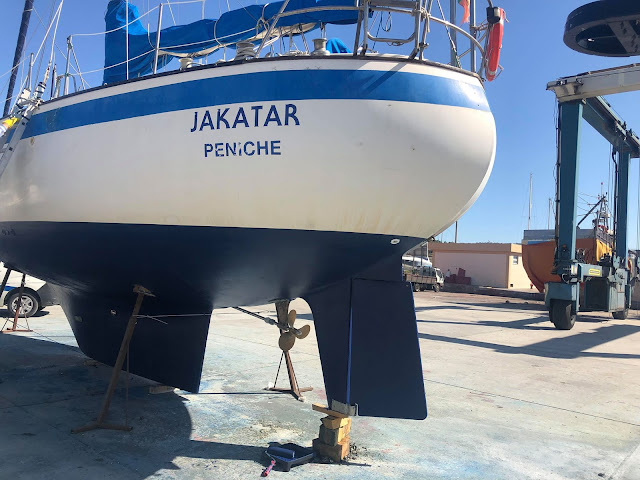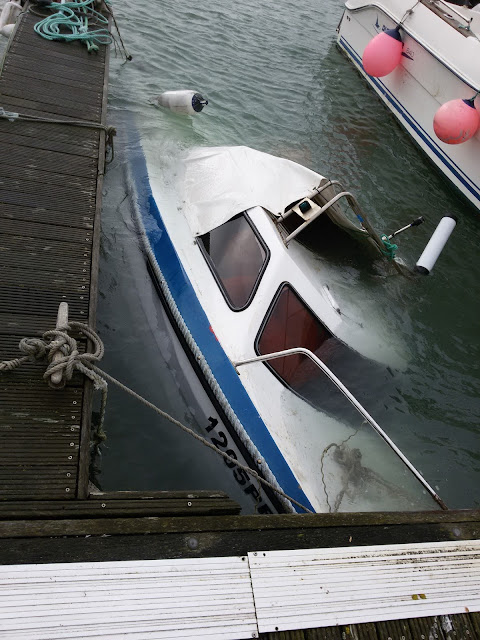I gave up my marina berth in Peniche and decided to place Jakatar on a mooring in Alvor, Algarve, 350 kilometres to the south. Since I would not have a car or a place to build a mooring ashore or even the means of deploying it, I decided to take all the materials from Peniche and to build the block on the boat and on-site in the Alvor anchorage.
Nearly everyone I talked to thought I was making a big mistake or downright crazy (even me at times!). But, as time went by, the idea began to grow on me and there was no way I would pass up this opportunity for yet another adventure in boat ownership.
About six months in advance I began to design a mooring that could be feasibly launched from the boat. It took some time before I discarded a number of dubious mooring designs: a steel box frame assembled on-site using pre-drilled bars weighed down with 20-kg precast concrete blocks; a bunch of concrete blocks tied to the stud link chain; or a long iron bar with large spikes weighed down with the above-mentioned concrete blocks.
In the end, I decided on making a single concrete block on-site. I planned and revised the procedure, step by step, to the smallest detail.
MaterialsIn the end, I decided on making a single concrete block on-site. I planned and revised the procedure, step by step, to the smallest detail.
Plywood box assembled on-site and on deck
A 4x4 pine lumber section under the box and fastened with an eyepiece as shown below
6 metres of 22 mm stud link chain
8 metres of 10 mm galvanised chain
10 mm high quality stainless steel swivel and galvanised shackles
18 metres of rebar cut into desired lengths
100 kg of cement
320 kg of coarse river sand
150 kg of dense beach stones of varying sizes
Pails, old blankets, tarp, etc.
Total cost: about 337 euros, not the including the mooring buoy which is also another invention
 |
| Eyelet piece going through the pre-drilled box and 4x4 lumber section, which held all the weight until the concrete cured. |
Step 1
Assemble the box on deck with screws. When finished, raise it with a foresail halyard and drop it on the dinghy alongside the boat.
Place fenders (preferably high density fenders) between the box and hull.
Move the box to the bow and fasten it temporarily with a line.
Place fenders (preferably high density fenders) between the box and hull.
Move the box to the bow and fasten it temporarily with a line.
Lower the heavy bottom chain and shackle it to the eyepiece.
Connect the heavy chain to the riser chain with a swivel and necessary shackles that must be moused using monel seizing wire or equivalent method.
Connect the heavy chain to the riser chain with a swivel and necessary shackles that must be moused using monel seizing wire or equivalent method.
Fasten a strong line (preferably Dyneema or Spectra) to a cleat that then runs through a link in the suspended heavy chain, as shown in the second photograph below, and which comes back up through the bow roller to the drum on the winch. Tie the bitter end to a cleat and give yourself enough excess line to drop the mooring to the bottom.
You could, optionally, also use a chain hoist fastened to the bow roller.
Tie another backup line to the chain, just in case the load-bearing line breaks or somehow comes loose.
Step 2
Place blankets, tarps, etc. on the fore-deck, pour cement into large bucket and sand into another. Use two smaller buckets to mix the concrete, 3 parts sand to 1 part cement.
Tie a a line to each bucket and lower them with the mixed concrete to box level.
Ideally, one person would mix the concrete and another would be in a dinghy below pouring the concrete into the box.
Place rocks in the concrete as you go along (rocks are heavier than concrete and thus lose less weight underwater).
Step 3
When full, allow the concrete to cure sufficiently (a few hours) so that it does not wash away.
Next, slowly drop the box to the bottom. Note that concrete cures better under water than when exposed to air (it's a chemical curing process rather than a drying process).
I let it cure for two days because I had 4 rebar pieces penetrating the box bottom (30 cm below and 20 cm into the box) for greater holding power. The concrete had to be sufficiently hard to hold these rebar pieces in place when the box hit the bottom.
Step 4
Position the boat at desired location using a second anchor. I did this at 3 a.m. when there was no traffic, no wind and at low tide. I rowed out a F-11 fortress anchor and then used it to pull the boat forward and to port.
Step 4
To lower the concrete mooring block, slightly loosen the bitter end of the line that is rolled onto the winch drum, give it 50 cm of slack and refasten to the cleat. If the line is wound 3 or 4 turns on the winch drum it will be held in place and you must ease it for it to slip. Don't get your fingers between the drum and the line. Always use a backup line tied to the chain and fastened to a strong point, and ease it accordingly.
Repeat this operation until the block lands on the bottom and then pull on the line to retrieve it.
Step 5
Get a drink, relax and celebrate. You've just built and deployed a 600 kg mooring block.
I used only 600 kg for a Corbin 39 sailboat because the bottom is soft mud in which the block will sink and create incredible suction holding power. I also have about 2.5 / 1 scope.
The heavy bottom chain is also sufficiently long to inspect the swivel and shackles between it and the riser chain simply by winching up the calibrated riser chain that comes aboard. The load is taken by two line snubbers, and the chain is attached to the boat as a bullet-proof backup. I sleep very well even on very windy nights.
With a bit of luck, the boat won't end up like this old English boat that sank in the anchorage a few years ago and which was refloated while I was building my mooring.
Warning
If you attempt to build a mooring in this manner, you need a boat with a sufficiently strong bow roller. A bow sheer also makes it a lot easier, otherwise you would need a rectangular box.






























